 |
| The Independent Traveler's Newsletter PAGE FOUR |
 |
| The Independent Traveler's Newsletter PAGE FOUR |
| The Lot département continued
. . . |
|
|
Your drive through the Lot might
take you to the village of St-Céré
straddling
the River Bave and near the Lot's northern border, complete with a
park, a popular market square, and
lovely medieval houses. Most interesting, and giving the town of
3500 something of which they can be proud, the the castle of Saint
Laurent les Tours is above the village on a hill and where
artist Jean
Lurçat operated a
secret wartime radio for the French resistance. Lurçat,
who began his artistic career as a
painter, is known for his revival of tapestries, and the first of 1000
tapestries he designed or made was in 1917 at the age of 25. He went
to Aubusson in 1939 establishing a center for producing modern
tapestries, his work was exhibited throughout Europe through the 1930s,
and two of his most noteworthy were made in the 1940s: the 'Apocalypse
Tapestry' and the 'Four Seasons'. At the end of the war,
Lurçat purchased the castle which he had come to love; it had
not only
been the choice for the Resistance radio broadcasts because of its high
strategic position, but it was his workshop and home.
Lurçat's
widow, Simone, continued to occupy the chateau after
his death in 1966 and, when she sold it in 1986 to the General Council
of the Lot, it was with the precondition that his workshop and a museum
dedicated to Jean Lurçat would always be in the castle. It
is now
a listed Monument
Historique
of France. There is also a museum dedicated to his tapestries in
Angers. 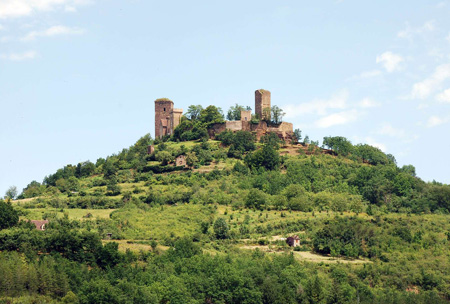 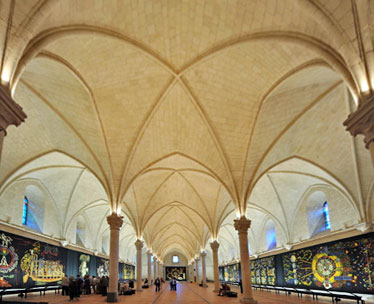
St-Cirq Lapopie
is
one
of those 'must see' places during any visit to the Lot. Perched
above the River Lot, visitors can park their cars at the base of the
hill and walk up to the village ~ it's not a steep climb. Their
Medieval festival will take place beginning the 9th of September with
the first of five nights of Son et Lumière shows; the Crafts and
Artisans Market will be open on the 12th and 13th with a lot of
interesting activities and entertainers to put everyone in a Medieval
spirit!
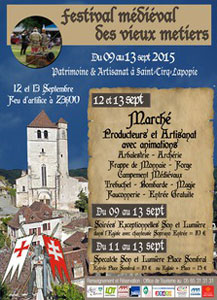  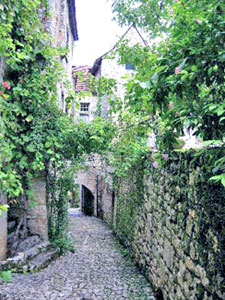 Medieval
Festival poster
St-Cirq Lapopie from the
River Lot
Village Lane
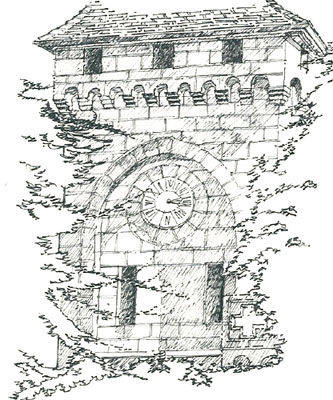 Les Plus Beaux Villages de
France Les Plus Beaux Villages de
FranceThere are six Plus Beaux Villages in Lot, and St-Cirq Lapopie is one of them. The other five are Autoire, Capdenac-le-Haut, Cardaillac, Carennac, and Loubressac. To qualify for this designation, a commune or village must meet strict criteria regarding a maximum population of 2000, at least two classified or protected monuments or sites, and proof that the entire village supports the village council in joining the organization. Each of these designated villages is well worth a visit. Last, but certainly not least, is a visit to Rocamadour. This is another perched village with a history involving pilgrims and the Black Madonna. The town overlooks a deep gorge defying gravity as its houses and other buildings were constructed up the steep cliff in stages on the River Alzou's right bank. The height is a dizzying 390 feet. 216 worn steps take you from the lower village up to the churches that are enormous structures half way up (an elevator is available as well). The primary one is the pilgrimage Eglise de Notre Dame, originally built in 1479, and renovated over time. Its main attraction is the wooden Black Madonna said to have been carved by Saint Amadour, the village's patron saint. This drawing is of the Castle Keep. Pilgrims would come here believing it was a place of miracles, and they would climb the steps on their knees as a form of penance. But, people lived here long before the village existed in shelters under the overhanging rocks, and in 1166 they discovered the miraculously preserved body of Saint Amadour at the place where today's sanctuaries are located. Durandel, the famous sword belonging to Roland, one of the twelve paladins in Charlemagne's court, is protruding from a rock wall. It is said that Roland threw the sword in the air to stop it from getting into Saracen hands, and it lodged itself into the rock wall where it remains over the shrine of the town's patron Saint Amadour. The Book of Miracles from 1172 told of Our Lady of Rocamadour would heal the sick, protect people at war, save sailors at sea and set prisoners free. It is this history of miracles that still attracts people to Rocamadour, its church of Notre Dame, the Basilica of Saint-Sauveur, and many smaller chapels. Whether you believe in miracles or not, you will think it is miraculous the way the town clings to the cliff side ~ quite an incredible feat of man using primitive methods and tools. Don't miss Rocamadour! 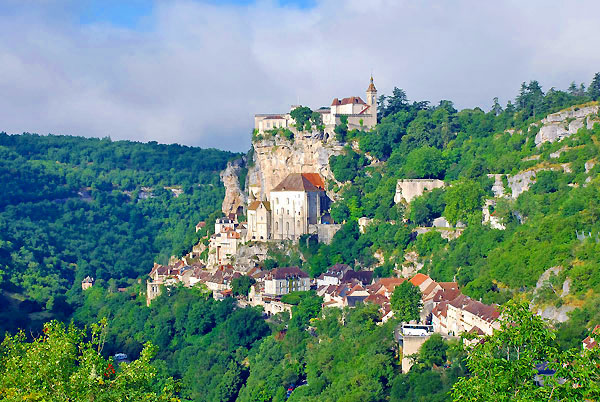 Dramatic
Rocamadour
Cuisine of the Lot The Midi-Pyrénées region, of which the Lot is a part, may be best known for its cassoulet ~ shown below ~ a specialty one-dish meal made with pork, mutton or duck, with sausages, garlic, shallots and tomatoes, and simmered with cannellini beans (white Italian kidney beans). There are other regional dishes such as 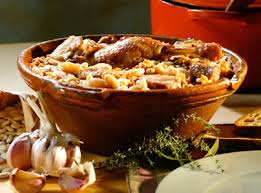 Soufflé
au Roquefort, served as
a warm hors-d'oeuvre. Made
with crumbled cheese and stiffly beaten egg whites, it is then folded
into a thick Béchamel sauce and baked in the oven until the
soufflé has
risen completely. This recipe originated using Gruyère
cheese, but it
was made regional by the substitution of Roquefort. Soufflé
au Roquefort, served as
a warm hors-d'oeuvre. Made
with crumbled cheese and stiffly beaten egg whites, it is then folded
into a thick Béchamel sauce and baked in the oven until the
soufflé has
risen completely. This recipe originated using Gruyère
cheese, but it
was made regional by the substitution of Roquefort.There are many other meat dishes including Tournedos au poivre vert (beef fillets in wine sauce) and Tourte quercynnoise (a savory pie of duck liver and mushrooms, quiche filling and then sprinkled with truffles). Truffles are an important part of the cuisine in southwestern France ~ truffle 'season' begins in November and ends in March. Truffles are also found in Provence and Burgundy. Pigs used to be used to find truffles under truffle oaks but often wanted to eat them; dogs are now more favored and they also go hunting with their owners for wild boar. The icy waters of streams from the Pyrénées bring fish down into the valleys providing ample varieties for use in the Lot cuisine. For a starter of saumon mariné and a main course of truite aux amandes, or truite meunière, or truite grenobloise, drive to the incredibly beautiful speck of a village Vers, on the tiny River Vers on the way south to Cahors. Here, along a scenic stretch of the D653, you will find the restaurant La Truite Dorée. The village is just west of St-Cirq-Lapopie and is a member of the Logis de France association ~ we've enjoyed their restaurants for decades and can recommend that you try them whenever you can! 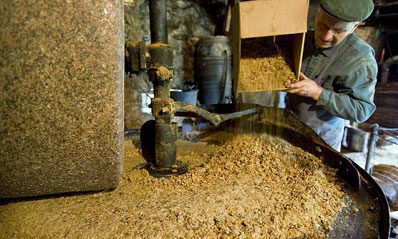 Martel, which we
mentioned earlier, has an historic, working walnut-oil mill, Moulin à Huile de Noix,
operated by the Castigné family, and it can be found on Route de
Saint-Céré in Martel. It is a former hunting lodge
that functions the year 'round, and visitors can observe how the
milling is done. In July and August oil is only milled on
Tuesdays and Thursdays. The farm shop sells both the walnut oil
they produce and hazelnut oil as well as the traditional 'walnut wine'
apéritif (vin de noix)
so popular in Quercy. It is open from April 1 to the 28th of
October, and they request that visitors make reservations through their
web site.
The Farm Auberge also serves lovely light meals. Only French is
spoken. Martel, which we
mentioned earlier, has an historic, working walnut-oil mill, Moulin à Huile de Noix,
operated by the Castigné family, and it can be found on Route de
Saint-Céré in Martel. It is a former hunting lodge
that functions the year 'round, and visitors can observe how the
milling is done. In July and August oil is only milled on
Tuesdays and Thursdays. The farm shop sells both the walnut oil
they produce and hazelnut oil as well as the traditional 'walnut wine'
apéritif (vin de noix)
so popular in Quercy. It is open from April 1 to the 28th of
October, and they request that visitors make reservations through their
web site.
The Farm Auberge also serves lovely light meals. Only French is
spoken.An important thing to remember is that local produce and products will result in the best cuisine. The people of the Lot are not wealthy, yet they eat very well. The food is rich and has high fat content, but their life expectancy is the highest in France! Add a glass of the local wine from the menu, and you will be more than satisfied dining in the Lot.
DISCLAIMER: You have received this newsletter because your email address is on our Opt-In mailing list, i.e., you have requested to receive FRANCE On Your Own ©. If you would like to discontinue receipt of this newsletter, please send an email to publisher@franceonyourown.com with "unsubscribe" on the Subject line. Unless indicated otherwise, photos, graphics, artwork and text in the FRANCE On Your Own © newsletter are all the property of Cold Spring Press and FRANCE On Your Own © and cannot be copied, duplicated or used in any manner by anyone without the express written permission of Cold Spring Press. FRANCE On Your Own © is published online by Cold Spring Press, P O Box 26098, San Diego, California 92196-0098. This publication is copyrighted and no portions of the text, artwork, graphics or photographs may be reproduced or distributed in any form or by any means or stored in a database or retrieval system without the written permission of the Publisher. For more information about FRANCE On Your Own ©, visit our web site at http://www.franceonyourown.com. Recommendations made in this newsletter are based upon the personal experiences of the Publishers or contributing writers solely to provide information to subscribers. Cold Spring Press and FRANCE On Your Own © make no endorsements nor are any guarantees or promises of satisfaction given or implied. Any and all information is correct to the best of our knowledge, and the Publishers accept no responsibility for errors and/or omissions. The responsibility lies entirely with the traveler to obtain current information regarding accommodations, availability, schedules, prices, reservations, or any other pertinent details. We do not guarantee the historical accuracy of the contents of articles in this newsletter. Historical accuracy is dependent upon one's sources of information -- and contradictions often exist among those sources. Links to other web sites or email addresses are provided for informational purposes only and do not imply any guarantees of service or endorsement of any organization or their business practices. FRANCE On Your Own © is electronically transmitted via email. To add your email address to our database for this FREE newsletter, send an email to info@franceonyourown.com, and please put Subscribe in the subject line. We do not share email addresses with any other organization. BACK ISSUES of the print version of FRANCE On Your Own © and Free online back issues are available on our web site at http://www.franceonyourown.com/Archives.htm. ©1998-2015
Cold Spring Press All Rights Reserved |
|
 previous
page
previous
page |